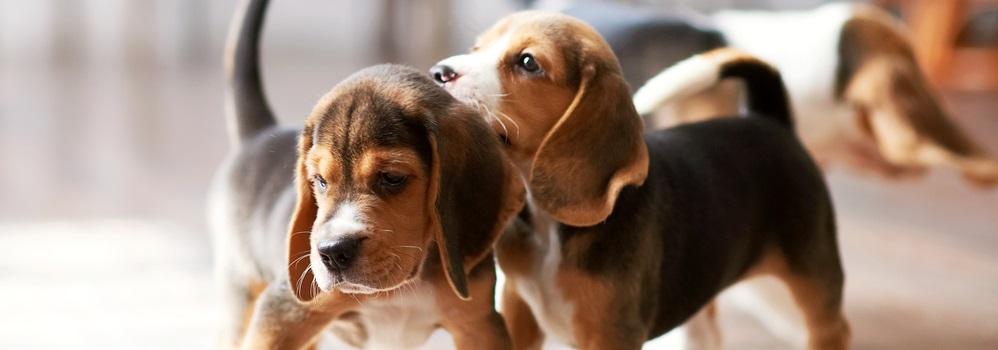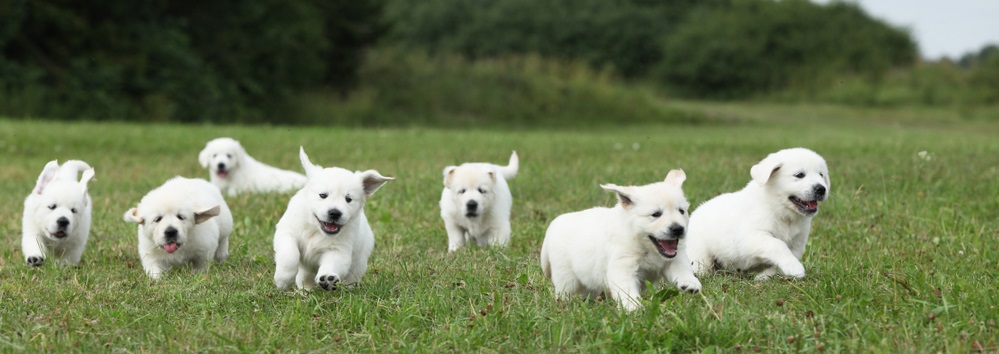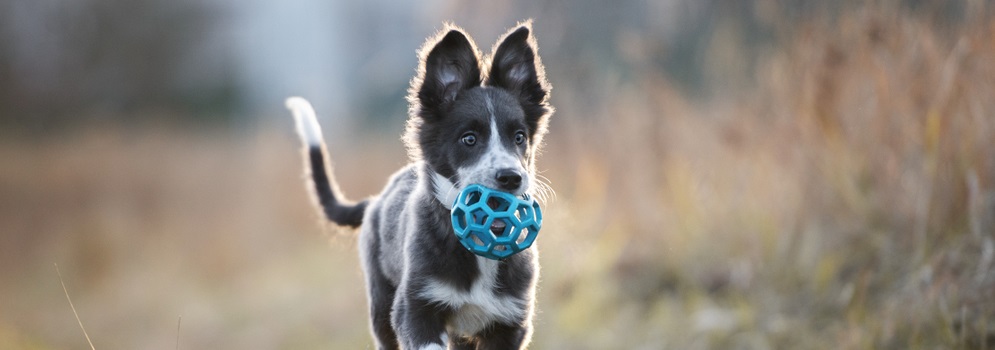Full of life, your puppy quickly hits the ground running—sprinting across the confines of your home as if they are about to finish their first 100-meter race. Not only is your puppy leaving you in a trail of dust, but they also have you wondering, why does my puppy have so much energy?
Just like being a first-time owner of anything, your new, furry bundle of joy is bound to come with a few surprises. While having an inherent need for speed is a common trait among young pups, it is still likely to catch you off guard. Want to understand why your four-legged housemate can’t sit still? Keep reading to learn the possible sources of your puppy’s energy while gleaning a few tips to help calm them down along the way!
For Puppies, Age Isn’t Just a Number
Just like an infant, young puppies are experiencing the world for the first time. In their pursuit of exploration, your puppy is also exploring boundaries: from what they can fit in their mouth to how fast they can run to the other side of the room. With their boundless curiosity, puppies not only amplify the energy of any space they’re in, but they can also test your patience at the same time.
You’ll be happy to learn that just like the spontaneous desire you once had to dye your hair hot pink, your puppy’s hyperactivity is probably just a phase.
Here is a basic breakdown of everything you need to know about your puppy and their energy levels (broken down per age):
- Birth to 8 Weeks: A lot, and we mean a lot, happens in these first weeks. Your pup not only learns the power of their own four legs and starts eating solid dog food, but they also begin their basic training in socialization. Playing with littermates and letting their curiosity run wild is not only a vital part of healthy mental development but physical development as well.
“During the early socialization period, a pup learns through experience to associate social and non-social stimuli with positive or negative emotions. These experiences allow the pup to build adaptive capacity in order to cope with and adapt to new situations.” – Dietz et al
- 8-16 Weeks: Noted by some as the teenage phase, puppies in this stage can become slightly rambunctious. Still curious and excited by their surroundings, your puppy may ignore your commands in pursuit of the prolific bushes next door. Around this phase, you might also want to start considering basic puppy training to help hone your puppy’s energy.
- 4-6 Months: Around this age, your puppy will begin to mock-fight with other pups, helping them to build confidence and continue strengthening their muscles. If your puppy exhibits anxiety or fear at this stage, it’s essential to sign up for a socialization program to reduce future behavioral problems.
- 6-12 Months: Depending on the type of your puppy’s breed, your puppy might be almost fully grown! This phase is associated with increased energy, which can lead to destructive behavior if your pup becomes too bored. A quick fix for this is continued socialization and giving them adequate time to run outside to burn some energy.
- 1-2 Years: At this point, your puppy will be fully grown, having reached maturity. While they should have a solid grasp on managing their energy and listening to commands, it’s important to continue socializing your dog to maintain their health and happiness.

Monitoring your pup during each phase is an important part of ensuring that your puppy grows up to be strong and healthy. If you have any concerns along the way, we suggest seeking expert advice from your pup’s veterinarian.
Socialize, Socialize, and Socialize Again
“Certainly, the high-energy breeds… are more prone to develop true hyperactive behaviors, but a dog’s genes are just the canvas that his personality is painted on by life, training, and socialization experiences.” – WholeDog Journal
If we didn’t say it enough earlier, a massive factor in your pup’s hyperactivity could be a lack of socialization. Socialization with other dogs and external stimuli is critical in a pup’s journey to discovering boundaries. In fact, the American Veterinary Society of Animal Behavior cites socialization as a key factor in avoiding behavioral problems such as aggression, separation anxiety, and avoidance.
Early socialization during the first three to twelve weeks will not only improve your bond with your puppy later down the line, but it can also help them safely interact and play with the outside world. Ultimately, the more time your pup spends exploring the great outdoors, the less time they will have to discover the inside of your new pillows.
Here are some tips to keep your pup healthy, happy, and hopefully, a bit calmer:
- Enroll in basic puppy training – Basic puppy obedience training is essential for several reasons. For one, a skilled dog trainer can teach your dog to understand basic commands while simultaneously exposing them to new stimuli. Just make sure you have proof of your puppy’s vaccinations before signing up.
- Take it slow – Taking care of your puppy can be a huge learning curve for both of you. For younger puppies, it’s especially important to introduce your puppy to new stimuli slowly. So before heading to your local fair, be sure to introduce your puppy to smaller things first.
- Engage in positive reinforcement – While having a tiny puppy with endless energy can be stressful, it’s crucial to maintain a positive and patient approach. As your puppy’s owner, you can enact positive reinforcement through appropriate praise and treats. Try to avoid negative reinforcement, such as periods of imposed isolation, as it often does more harm than good.
- Explore the world with your pup – At the end of the day, having a puppy is an exciting journey! As your pup gets older, continue to expose them to new stimuli: from a quick walk to the local dog park to a voyage to your local pet store. Getting your puppy outside will not only improve their behavior, but it can also burn some of that endless energy too.
Don’t Forget the Exercise!
Is your puppy in a high-chase pursuit for seemingly anything? A puppy not getting enough exercise will often spend the day grabbing, sprinting, and acting uncontrollably. While certain dog breeds are more prone to chase down the mailman than others, it’s essential to make sure that your puppy is getting the exercise they need.

For physical exercise, make sure you have a space that’s large enough to fit your puppy’s sprinting needs. This space could come in the form of a backyard, a local park, or even a homemade obstacle course. While some puppies are tired out after one session of exercise, this isn’t always the case: your pup might need two!
If running all day outside isn’t enough for your puppy, consider some fun alternatives when your puppy gets too hyper, such as a chew toy or a game of catch. It might also be helpful to note when your puppy gets sleepy and when they can’t seem to sit still, because, as it turns out, puppies tend to have a built-in cycle.
Note: Be sure to check with your vet and establish what a healthy amount of exercise is for your puppy and breed. At times, too much exercise at an early age can be bad for their developing joints. This is simply something to be aware of.
While physical exercise is a great way to manage your puppy’s energy, it’s also equally important to train their mind! Mental exercise can begin at home, and here are a few of our favorite tips to keep your puppy’s mind active:
- Play hide and go seek – Playing a few rounds of hide-and–go–seek with your puppy not only engages them mentally, but it also strengthens your bond with them at the same time.
- Invest in some fun puzzle toys – Tire out your pup and boost their mental training with some fun toys! Puzzle toys not only challenge your puppy mentally, but they’re also a good distraction for when your puppy’s energy spikes.
- Teach your dog new tricks– Once your puppy has the basic commands down, try expanding your puppy’s lexicon by teaching them new tricks.
Great exercise also requires great nutrition, so make sure to keep your puppy healthy and active with Vetericyn’s ALL-IN Puppy supplement. Vetericyn’s ALL-IN Puppy supplement supports your puppy’s growth and development every step of the way, from promoting mineral absorption to giving your puppy all of the vitamins they need to grow up healthy and strong.
Don’t Fret! Having an Energetic Puppy is Normal
Boundless energy is often a mixture of genes and environment, so it’s important to consider both when assessing your puppy’s hyperactivity. You may need to channel your puppy’s energy into a daily outdoor sprint, or introduce them to other doggos (or both)!

It’s also important to note that honing your puppy’s energy will take some trial and error, so remember to keep calm and collect yourself. Dogs can read your emotions, and they even absorb them as well—so if you’re stressed out, your puppy might feel it too.
Ultimately, the learning curve with any puppy is always a steep one. Thankfully, not only are bouts of energy normal in young puppies, but there are also plenty of resources available to help you through any growing pains. Now that we’ve answered the question why do puppies have so much energy, you can begin training your high energy dog and start getting some sleep! However, if you feel like your puppy is too hyperactive, we always recommend consulting your veterinarian.
Sources:
- American Veterinary Society of Animal Behavior. AVSAB Position Statement
- On Puppy Socialization. https://avsab.org/wp-content/uploads/2018/03/Puppy_Socialization_Position_Statement_Download_-_10-3-14.pdf
- WholeDog Journal. Think Your Dog Has ADHD? https://www.whole-dog-journal.com/behavior/think-your-dog-has-adhd/
- Dietz et. al. The importance of early life experiences for the development of behavioural disorders in domestic dogs. https://brill.com/view/journals/beh/155/2-3/article-p83_1.xml?language=en
- The Spruce Pets. Puppy Development From 3 to 6 Months. https://www.thesprucepets.com/puppies-three-to-six-months-4570930
- Lovepets. Puppy Socialization 101. lovepets.com/puppy-socialization-101
- Vetericyn. Products. https://vetericyn.com/all-in/
- World Animal Protection. Dogs and Emotions. https://www.globalanimalnetwork.org/dogs-and-emotions?gclid=EAIaIQobChMIjcDT9eWN5wIVEtvACh279AT-EAAYASAAEgIa7_D_BwE
 Dr. Melinda J. Mayfield-Davis, DVM, WCHP-AH, brings over 20 years of experience in veterinary medicine. She is the Technical Services Veterinarian with Innovacyn, Inc., parent company of Vetericyn Animal Wellness. She received her DVM from Oklahoma State University and now resides in Southeast Kansas with her husband, two children, four dogs, and six horses. Prior to working with Innovacyn, Dr. Mayfield owned and operated the Animal Care Center in Columbus, KS.
Dr. Melinda J. Mayfield-Davis, DVM, WCHP-AH, brings over 20 years of experience in veterinary medicine. She is the Technical Services Veterinarian with Innovacyn, Inc., parent company of Vetericyn Animal Wellness. She received her DVM from Oklahoma State University and now resides in Southeast Kansas with her husband, two children, four dogs, and six horses. Prior to working with Innovacyn, Dr. Mayfield owned and operated the Animal Care Center in Columbus, KS.


